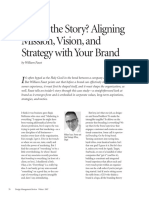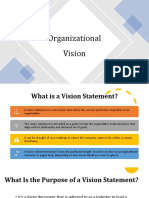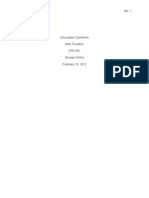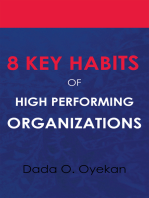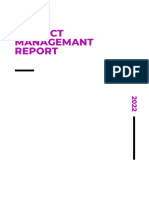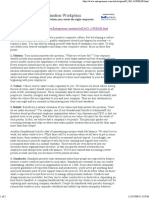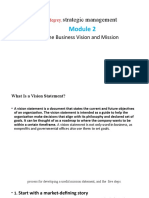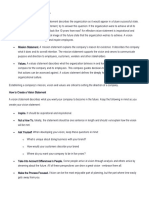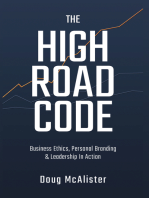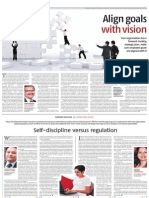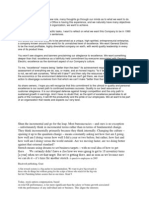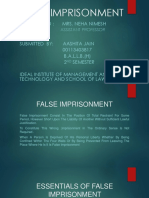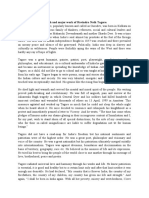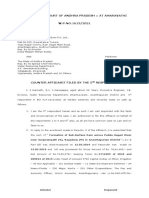The Wallpaper Effect
Uploaded by
sushmesundarThe Wallpaper Effect
Uploaded by
sushmesundarThe wallpaper effect
C. Mahalingam Share print T+ T+   TMission statements needn't remain decorative elements if the values therein are structured into an organisation's work routines.
Are your eyes glazing over with the show and the dazzle? _ G. Ramakrishna We have come a long way with the kaleidoscopic collection of wallpapers in the marketplace. The riot of colours and designs on the wall never cease to amaze. I have, many a time, kept gazing at and admiring the wallpaper and realise that I am not the only one, but many of my friends do so as well. Long live the creative minds that design, deliver and use these, for these are so pleasing to the eye and soothing to the soul! Well, the story is not just the wallpaper today, but something else that happens thereafter. You come back home and think about it, you can seldom recall and describe what you witnessed and enjoyed! At best, your description will be vague and blurred! Welcome to the world of mission, vision and values in organisations! Thanks to many management gurus and their best-selling books, organisations the world over have produced high-sounding vision, mission and value statements and displayed them all over the office premises. Induction programmes invariably have sessions where someone supposedly senior enough in the organisation waxes eloquent for an hour on the organisation's vision and mission, projecting the same on the screen. That is good news. After all, visions describe the desired future for the organisation and values guide the journey of the organisation like the North Star. Now the bad news is that all the commitment to vision and values ends right there. Call that the wallpaper effect! You see the glassy, jazzy vision-mission-value posters displayed prominently in the hallways, customer-briefing rooms, cafeteria, gym and even toilets. The more the merrier so employees will hopefully read, absorb and internalise. The wallpaper effect does not spare even the CEOs!
In an interesting experiment by a leading consulting firm in US, the consultants invited a select group of CEOs and seated them in the boardroom. Shortly after mutual introductions, the consultants informed that the CEOs have a simple task to perform choosing their organisation's vision statement from the bowl that contained the vision statements of all the companies that the CEOs represented! These vision statements were downloaded from the Web sites of the respective companies, but the catch was that before they went into the bowl, the company names were cut out! Guess what happened? Most of the assembled CEOs had a hard time picking their company's vision statement! The difficulty revolved around two things: (a) Almost all the vision statements read very similar; and even more noticeably (b) many of the CEOs could not recollect their company's vision statement! Now what does this have to do with the wallpaper effect? Simply put, vision-mission statements are not posters to display but exemplify the purpose of existence and road map for focus. The dark reality is in many organisations, these are no more than the wallpaper that we admire in restaurants and function halls only to forget soon thereafter! Visionary companies do things very differently and at one extreme, may not even have verbose vision statements spelt out. They live and breathe a certain set of values and everyone can articulate this from the CEO to the front office assistant. Vision statements need more than articulation and memory recall. Great companies use them to convey a shared mindset and dream to pursue collectively. Values are again not empty slogans, but something that guide the daily routines and decisions. One approach organisations have taken is to drill down the vision and values into a way of working'. In Hewlett-Packard company of yesteryear, this was known as the rules of garage. It served as the guiding norm for daily behaviour through which the values were lived everyday by everyone in the company. I see a distinct role for HR leaders who would like to bring the values of their companies to life - build your own version of the rules of the garage, or call it rules of the cubicle if you like it, and weave it into the measurement process to ensure everyone conducts the daily routines by these rules! C. Mahalingam is Executive Vice-President & Chief People Officer with Symphony Services Corporation. He can be reached at [email protected]
You might also like
- Make Your Brand Legendary: Create Raving Fans With the Customer Experience EngineFrom EverandMake Your Brand Legendary: Create Raving Fans With the Customer Experience EngineNo ratings yet
- The Risk of Racial Bias in Hate Speech Detection100% (1)The Risk of Racial Bias in Hate Speech Detection11 pages
- Story - Aligning With Mission, Vision PDFNo ratings yetStory - Aligning With Mission, Vision PDF7 pages
- Midterm Business Ethics - Vanessa Catalina FuadiNo ratings yetMidterm Business Ethics - Vanessa Catalina Fuadi16 pages
- 1.0.0 (A) The Eight (8) Benefits of Having A Clear Vision and Mission Statement100% (1)1.0.0 (A) The Eight (8) Benefits of Having A Clear Vision and Mission Statement20 pages
- Branding in The Digital World - Thinking Beyond Logos and Colour Palettes100% (1)Branding in The Digital World - Thinking Beyond Logos and Colour Palettes72 pages
- Ignite Your Culture: 6 Steps to Fuel Your People, Profits and PotentialFrom EverandIgnite Your Culture: 6 Steps to Fuel Your People, Profits and PotentialNo ratings yet
- How To Adapt Company Culture For Remote WorkNo ratings yetHow To Adapt Company Culture For Remote Work16 pages
- London Business School Rev - 2015 - Goffee - Why Should Anyone Work HereNo ratings yetLondon Business School Rev - 2015 - Goffee - Why Should Anyone Work Here3 pages
- Declaration: Forefathers Group Design StrategyNo ratings yetDeclaration: Forefathers Group Design Strategy14 pages
- Vision Setting Facilitation Guide: Design thinking Step-by-Step Ebooks, #1From EverandVision Setting Facilitation Guide: Design thinking Step-by-Step Ebooks, #1No ratings yet
- Article - How To Become A Destination Workplace PDFNo ratings yetArticle - How To Become A Destination Workplace PDF2 pages
- Outshine Your Competitors - 5 Step Branding BlueprintNo ratings yetOutshine Your Competitors - 5 Step Branding Blueprint7 pages
- Strategic Management: The Business Vision and MissionNo ratings yetStrategic Management: The Business Vision and Mission24 pages
- deComplify: How Simplicity Drives Stability, Innovation and TransformationFrom EveranddeComplify: How Simplicity Drives Stability, Innovation and TransformationNo ratings yet
- The HR Trailblazer: Unlock the Potential of Your Employer BrandFrom EverandThe HR Trailblazer: Unlock the Potential of Your Employer BrandNo ratings yet
- Optimizing Quality Systems With Design ThinkingNo ratings yetOptimizing Quality Systems With Design Thinking26 pages
- The Culture Map_ A Systematic & Intentional Tool For Designing Great Company CultureNo ratings yetThe Culture Map_ A Systematic & Intentional Tool For Designing Great Company Culture2 pages
- Turning People into Teams: Rituals and Routines That Redesign How We WorkFrom EverandTurning People into Teams: Rituals and Routines That Redesign How We WorkNo ratings yet
- Shun The Incremental and Go For The LeapNo ratings yetShun The Incremental and Go For The Leap4 pages
- Organizational Vision and VisionaryOrganizationsNo ratings yetOrganizational Vision and VisionaryOrganizations22 pages
- THE CUP OF COFFEE ANALOGY: The Ultimate Guide to Building a Brand in the Digital AgeFrom EverandTHE CUP OF COFFEE ANALOGY: The Ultimate Guide to Building a Brand in the Digital AgeNo ratings yet
- BBP Form Title: Bangsamoro Budget Preparation (BBP) Forms and InstructionsNo ratings yetBBP Form Title: Bangsamoro Budget Preparation (BBP) Forms and Instructions30 pages
- False Imprisonment: Submitted To: Mrs. Neha NimeshNo ratings yetFalse Imprisonment: Submitted To: Mrs. Neha Nimesh12 pages
- COMPASS Partnerships+Addressing+Disadvantage RFPNo ratings yetCOMPASS Partnerships+Addressing+Disadvantage RFP68 pages
- Appendix A Open Seawater Intake and Brine Outfall AssessmentNo ratings yetAppendix A Open Seawater Intake and Brine Outfall Assessment56 pages
- BPROAD Trial - Intensive BP Control for T2D (2024)No ratings yetBPROAD Trial - Intensive BP Control for T2D (2024)13 pages
- Cryptologic Aspects of GermansInSouthAmericaWW2No ratings yetCryptologic Aspects of GermansInSouthAmericaWW2104 pages
- MDaemon Mail Server Installation Guide Amirz Com100% (1)MDaemon Mail Server Installation Guide Amirz Com19 pages
- Fundamentals of Financial Management Concise 8E: Eugene F. Brigham & Joel F. HoustonNo ratings yetFundamentals of Financial Management Concise 8E: Eugene F. Brigham & Joel F. Houston17 pages







